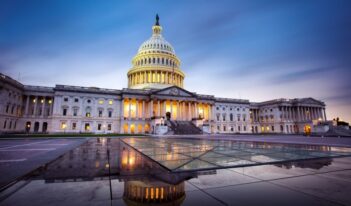
Leading regulatory scholars and professionals offer valuable lessons for achieving successful regulation.
Regulators occupy an important role in society. They are tasked with overseeing and managing industries as diverse as healthcare, energy, and finance. Their responsibilities include making difficult policy determinations and managing relationships with regulated industries, interest groups, other regulators, and lawmakers. But how can regulators know whether they are being as successful as possible in achieving their missions? How can regulators know whether they have achieved regulatory excellence?
A recent book, Achieving Regulatory Excellence, offers insights and strategies for improving the quality of regulation and regulatory management. The book, edited by Cary Coglianese, a University of Pennsylvania Law School professor and director of the Penn Program on Regulation (PPR), grows out of the PPR’s Best-in-Class Regulator Initiative sponsored by the Alberta Energy Regulator (AER).
 Writing in the Foreword to Achieving Regulatory Excellence, Jim Ellis, AER’s President and CEO, explains that the book helps to inform “a journey that many regulators around the world are pursuing.” He notes that “by living out the ideas reflected in this book regulatory leaders will be well positioned to build ‘great organizations’ that have the potential to create transformative and exceptionally positive impacts for citizens, communities, and entire economic sectors.”
Writing in the Foreword to Achieving Regulatory Excellence, Jim Ellis, AER’s President and CEO, explains that the book helps to inform “a journey that many regulators around the world are pursuing.” He notes that “by living out the ideas reflected in this book regulatory leaders will be well positioned to build ‘great organizations’ that have the potential to create transformative and exceptionally positive impacts for citizens, communities, and entire economic sectors.”
This series in The Regulatory Review includes nine essays authored by our writers and editors, each focused on a separate chapter in Achieving Regulatory Excellence.
The essays cover chapters written by accomplished regulatory scholars and professionals, including Cary Coglianese at the University of Pennsylvania Law School; John Braithwaite, a professor at the Australian National University; Wendy E. Wagner, professor at the University of Texas School of Law; John D. Graham, Dean of the School of Public and Environmental Affairs at Indiana University; Paul R. Noe, Vice President for Public Policy at the American Forest & Paper Association; Daniel C. Esty, professor at Yale Law School; Shelley H. Metzenbaum, former founding President of The Volcker Alliance; Gaurav Vasisht, Director of Financial Regulation at The Volcker Alliance; Adam M. Finkel, Senior Fellow at the Penn Program on Regulation; Neil Gunningham, professor at the Australian National University; and David J. Vogel, a professor at the University of California, Berkeley.
The series concludes with an essay on a panel discussion organized around the book, and held at the University of Pennsylvania Law School, that featured Coglianese, Ellis, and several other contributors.
What Makes Achieving Regulatory Excellence So Difficult
January 2, 2018 | Justin S. Daniel, The Regulatory Review
What is it about what regulators do—and the environment in which they operate—that makes achieving excellence so difficult? Cary Coglianese explains in his opening chapter in Achieving Regulatory Excellence that regulators face varied and competing pressures, high public expectations, a need to maintain effective relationships with industry, and often unclear guidance from legislators. According to Coglianese, the business of regulating is even more challenging than other lines of professional work.
Excellent Regulators Seize Transformative Opportunities
January 3, 2018 | Leah Wong, The Regulatory Review
John Braithwaite draws on the experiences of the Federal Bureau of Investigation and an Australian consumer agency to describe what he deems the hallmark of regulatory excellence: the ability of regulators to seize opportunities that will transform industries or the public for good. According to Braithwaite, regulators who fixate only on following rules cannot address society’s most pressing regulatory problems that need bold, creative solutions.
The Keys to Regulatory Excellence
January 4, 2018 | Sarah Kramer, The Regulatory Review
In her chapter of Achieving Regulatory Excellence, Wendy Wagner argues that the best regulators possess a strong commitment to promoting the public interest and to involving all affected parties in regulatory decision-making. To assess how well a regulator is doing, she favors process-based measures over output-based measures, because the latter may force an agency to consider only one way to advance the public interest and thus prevent regulators from exploring innovative alternatives.
Forcing Regulators to Put Society First
January 8, 2018 | Bryan C. Williamson, The Regulatory Review
Two former White House regulatory officials—John Graham and Paul Noe—argue that excellent regulators need to do better analysis to ensure that each regulation they develop helps society more than it hurts it. Reflecting on their experiences working in the Office of Information and Regulatory Affairs in the Office of Management and Budget during the Bush Administration, they urge legislators to require regulators to adopt an outcome-oriented approach to regulatory excellence.
Using Private-Sector Principles to Achieve Regulatory Excellence
January 9, 2018 | Alex Kang, The Regulatory Review
In his chapter of Achieving Regulatory Excellence, Daniel C. Esty presents lessons regulators can take from business management to improve their performance. Drawing on his own experience leading Connecticut’s major energy and environment department, Esty observes that the private sector has devoted a great deal of attention to managerial excellence. Esty argues that government regulators can apply these same core principles to their own work.
A Regulator’s Tools for Excellence
January 10, 2018 | Alex Walsh, The Regulatory Review
For Shelley Metzenbaum and Gaurav Vasisht, the core of regulatory excellence lies in the regulator’s ability to further its mission. They argue that an excellent regulator “is one that is adequately funded, that wisely manages its resources, and that effectively navigates its external relationships so as to act even under difficult circumstances for the purpose of furthering its mission.”
The Right Kind of Regulatory Excellence
January 11, 2018 | Taylor Daily, The Regulatory Review
Adam Finkel argues that inherent tradeoffs in most well-accepted regulatory virtues mean that excellent regulators succeed by exhibiting the correct balance of virtues. He notes frequent tensions or tradeoffs in the virtues that regulators should embody, arguing that regulators should be aware that over-pursuing some virtues will close off the opportunity to display others.
Achieving Better Regulatory Compliance
January 15, 2018 | Eric Schlabs, The Regulatory Review
In his chapter of Achieving Regulatory Excellence, Neil Gunningham lays out the key strategic enforcement choices facing regulators. He offers guidance for regulators when choosing among various enforcement strategies, arguing that a regulator must choose an enforcement strategy based on its likely effectiveness in reducing the social and economic harms that regulations seek to reduce.
What the FDA Can Teach Us About Regulatory Excellence
January 16, 2018 | Jennifer Ko, The Regulatory Review
David Vogel examines different regulatory responses to issues of public health, safety, and the environment in the United States and Europe, distilling key principles for achieving successful regulation. He emphasizes in particular the need for regulators to respond to new information as it emerges and to recognize the accomplishments and shortcomings of previous decisions.
How Regulators Can Excel
January 17, 2018 | Sara Bodnar, The Regulatory Review
Last year, the Penn Program on Regulation (PPR) convened a panel discussion around the recent book, Achieving Regulatory Excellence, edited by PPR Director Cary Coglianese. Much discussion stressed the importance of empathetic engagement between regulators and all those affected by their decisions and the need for regulators to find affirmative ways to engage with the public.



